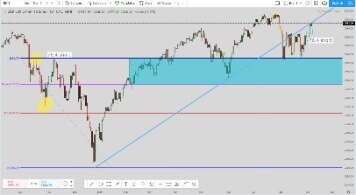Companies that sell products directly to consumers (as opposed to industrials) have proven themselves over decades. Bull markets in recent years have tended to be powered by such companies, but more importantly, they may be a decent safe harbor during downturns as well. Consider investing in these equities, or in a large-cap mutual fund with such stalwarts. After the October 2022 low point, the stock market was able to recover some of its losses in the fourth quarter.

While there are many different ideas on how the term bull market came to be, it’s generally believed that it comes from how a bull attacks. A bull thrusts its horns upward when it attacks, so the term was adapted to describe stock market growth. The terms «bear» (for down markets) and «bull» (for up markets) are thought by some to derive from the way in which each animal attacks its opponents. That is, a bull will thrust its horns up into the air, while a bear will swipe down.
bull3
Although it is hard to determine when the bottom and peak will take place, most losses will be minimal and are usually temporary. Below, we’ll explore several prominent strategies investors utilize during bull market periods. However, because it is difficult to assess the state of the market as it exists currently, these strategies involve at least some degree of risk as well. Since bull markets are difficult to predict, analysts can typically only recognize this phenomenon after it has happened.
As the price declines, bull investors must choose whether to hold or sell the security. A bull is an investor who thinks the market, a specific security, or an industry is poised to rise. Investors who adopt a bull approach purchase securities under the assumption that they can sell them later at a higher price. It’s almost impossible to tell when the market is at its peak, and even professionals rarely manage to call it right.

Nonetheless, perhaps the most common definition of a bull market is a situation in which stock prices rise by 20% or more from recent lows. Bullishness and bearishness do not necessarily apply only to the stock market. People can be bullish or bearish on any investment opportunity, including real estate and commodities, such as soybeans, crude oil, or even peanuts. It can be tempting to go all-in on a hot stock or sector when the market has been growing, but the end may be closer than you think.
What does bull mean?
Bull markets can last for years, but they must eventually come to an end. When the stock market experiences a prolonged downturn, it’s called a bear market. The longest stock market bull run lasted for 11 years—it started in March 2009 in the wake of the Great Recession and ended in March 2020 when the Covid-19 pandemic shut down the global economy. The longest bull market in the history of the S&P 500 index lasted from March 2009 to February 2020 and saw the index gain over 300%. This bull market was characterized by strong earnings growth, low interest rates, and investor optimism.
When the economy hits a rough patch, for instance in the face of recession or spike in unemployment, it becomes difficult to sustain rising stock prices. Moreover, recessions are often accompanied by a negative turn in investor and consumer sentiment, where market psychology becomes more concerned with fear or reducing risk than greed or risk-taking. Companies that are performing well in a bull market may also choose to reward their shareholders by increasing dividends, which can be attractive for income-focused investors. Bear investors believe that the value of a specific security or industry is likely to decline in the future. A bear market occurs when the market experiences prolong price declines—typically when securities prices fall by 20% or more and there is negative investor sentiment.
Words related to bull
You can usually tell which animal in a pasture is a bull by its large size and horns. Others point to Shakespeare’s plays, which make reference to battles involving bulls and bears. In «Macbeth,» the ill-fated titular character says his enemies have tethered him to a stake but «bear-like, I must fight the course.» In «Much Ado About Nothing,» the bull is a savage but noble beast. Improve your vocabulary with English Vocabulary in Use from Cambridge.Learn words you need to communicate with confidence. These examples are programmatically compiled from various online sources to illustrate current usage of the word ‘bull.’ Any opinions expressed in the examples do not represent those of Merriam-Webster or its editors. Old French boule (“ball”), from Latin bulla (“round swelling”), of Gaulish origin.
Opportunities to assume the position of a bull investor exist even when an overall market or sector is in a bearish trend. Bull investors look for growth opportunities within the down market and may look to capitalize should market conditions reverse. The term «bull» is also believed to describe how confident investors «charge» the market, much like how provoked bulls tend to charge at full speed toward their opponents. But experts are still mixed on what the rest of the year could look like. When attempting to time the market, you risk buying high before the market declines. That can lead you to make rash decisions, like selling at a loss to try and salvage some cash.
How long do bull markets last?
The best investment apps offer a range of investment options (including stocks, bonds, and cryptocurrencies) and market access. Some of the best investment apps for beginners also provide educational resources, research access, and human advisors for low fees. A male bovine — or cow — is a bull, and so is a male whale or elephant. Fittingly, the word bull is sometimes also used for a particularly bulky, muscular man.
These include an increase in trading volume, as more investors are willing to buy and hold onto securities in the hopes of realizing capital gains. Securities in a bull market also tend to receive higher valuations, as investors are willing to pay more for them due to the perceived potential for price appreciation. Despite the inevitable dips, over an extended time horizon, the stock market has never failed to rise. So not being invested in the market means missing out over the long haul. Like a savvy matador, individual investors should keep an eye on the bull’s moves, and adjust accordingly — but always stay focused on their overall strategy and goals. There is no specific and universal metric used to identify a bull market.
By doing this, you’re buying more shares when the price is low and fewer shares when the price is high. Perhaps the most aggressive way of attempting to capitalize on a bull market is the process known as full swing trading. Investors utilizing this strategy will take very active roles, using short-selling and other techniques to attempt to squeeze out maximum gains as shifts occur within the context of a larger bull market.
Evaluation of administrative case definitions for hypertension in … – Nature.com
Evaluation of administrative case definitions for hypertension in ….
Posted: Thu, 11 May 2023 10:21:54 GMT [source]
Bulls appears as charges and crests on the arms of several British families. Winged bulls appear as supporters in the arms of the Worshipful Company of Butchers.[38] In modern times, the bull is used as a mascot by both amateur and professional sports teams. Bull investors must be mindful of what is commonly known as bull traps.
Most are capable of aggressive behavior and require careful handling to ensure safety of humans and other animals. Bullish stocks are typically defined as stocks that display a bullish price pattern. In order to identify bullish stocks, there’s no substitute for learning the ins and outs of technical analysis.

The gains for the S&P alone amounted to over $18 trillion on paper, and during the period unemployment was at a 40-year low, at under 4%. Though a charging bull and a hibernating bear are useful images, bear and bull markets are thought to have gotten their names from the way they attack. Some investments — like the Mega Cap tech stock, which is approaching a 50% gain compared to 2022 — are showing promising improvements.
The opposite of a bull market is a bear market, which is characterized by falling prices and investor pessimism. The terms «bull» and «bear» are believed to come from the way these animals attack their opponents. A bull market is an extended period of time when stock prices rise and investors are optimistic. Bull markets can last for months or even years, and stocks tend to outperform other investments like bonds. Bull markets generally take place when the economy is strengthening or when it is already strong. They tend to happen in line with strong gross domestic product (GDP) and a drop in unemployment and will often coincide with a rise in corporate profits.
- They are also incorporated into festivals and folk events such as the Running of the Bulls and were seen in ancient sports such as bull-leaping.
- Because it’s impossible to tell when a market has reached its top from a ground-level perspective, it’s very difficult to foresee the turning point before you are in it.
- These are just a few examples of some of the biggest bull markets in history.
- Adam Hayes, Ph.D., CFA, is a financial writer with 15+ years Wall Street experience as a derivatives trader.
But it always does, after an external force affects investors’ feelings about the future and stock prices start to look too pricey. Let’s break down just what bull markets are, how it differs from a bear market, and what they mean for both institutional and individual investors. Some investors watch for retracements within a bull market and move to buy during these periods. During a bull market, there are several characteristics that can be observed.
A bull market is a financial market characterized by rising prices and investor optimism. It is most commonly used to refer to the stock market, but can also refer to the bond, real estate, currency, https://trading-market.org/bull-definition/ and commodity markets. Bull markets tend to last for extended periods of time and are marked by increased demand for securities, rising corporate profits and GDP, and declining unemployment.
